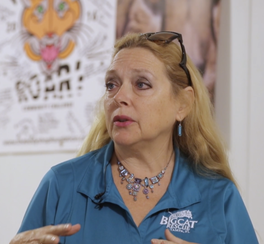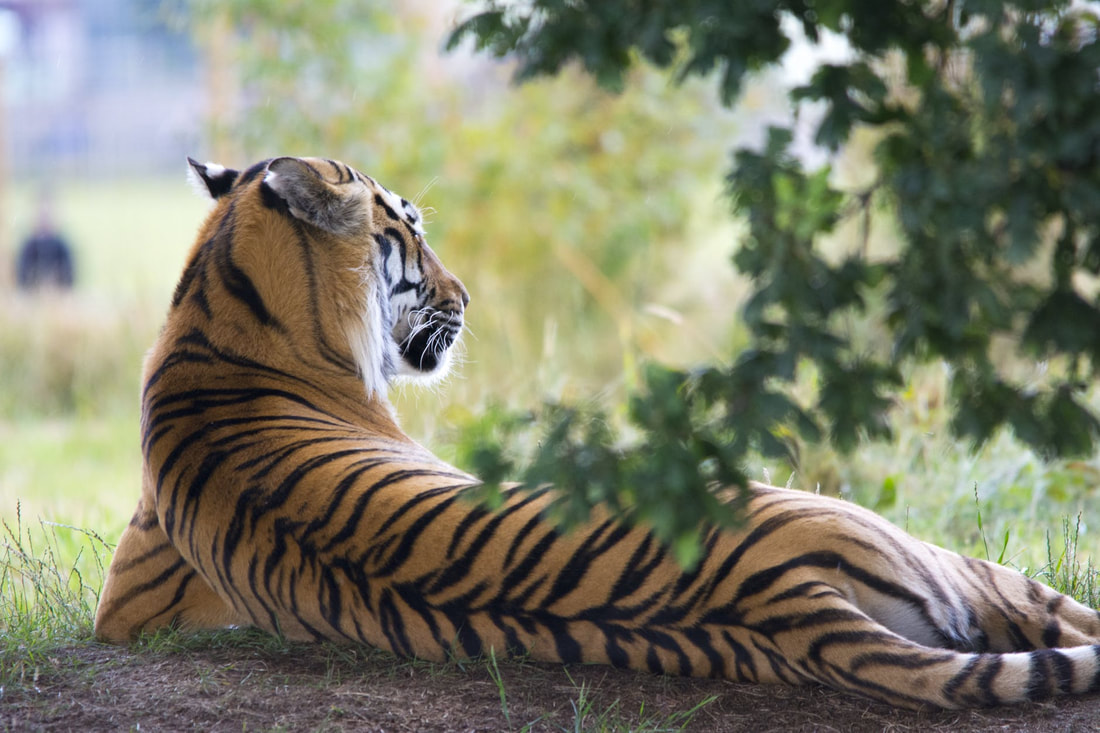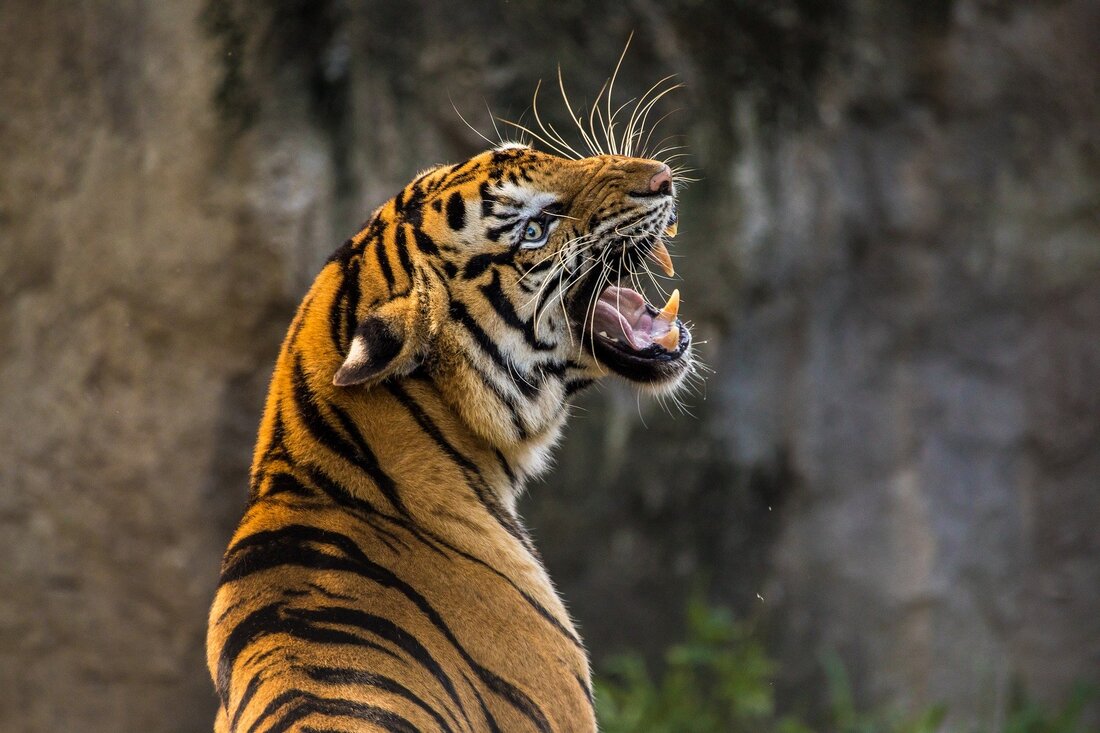|
Written by: Sarika Khanwilkar, PhD researcher with Columbia University and The Fulbright Program, and Founder of Wild Tiger, a nonprofit committed to conserving India’s Bengal Tigers and their habitat. She was a Jackson Wild Media Lab Fellow in 2019. Tiger King: Murder, Mayhem, and Madness is a new docu-series on Netflix. The outlandish characters, mainly Joseph Maldonoda-Passage (better known as Joe Exotic), Kevin ‘Doc’ Antle, and Carole Baskin (of Big Cat Rescue), make it a noteworthy conversation piece and have inspired meme-makers everywhere. I have been doing research on wild tigers in India and America’s captive tigers for years. Here are the ten most important things I want you to know about Tiger King. (Please note: Spoiler alert! Stop reading if you want to avoid spoilers and finish watching The Tiger King on Netflix.)  1. Tiger King missed an opportunity to make impactful media and misrepresented the work of a legitimate conservation organization. The filmmakers started the Tiger King project with the intention of making something like Blackfish, which ignited public outcry over the confinement of whales as entertainers in places like SeaWorld. The ‘Blackfish Effect’ led to decreased SeaWorld attendance and stock prices, and they subsequently stopped orca breeding and theatrical shows. Tiger King ended up being a sensationalized narrative that pitted narcissistic tiger breeders and owners against seemingly hypocritical animal rights advocates. The series failed to communicate the conservation issues related to the uncontrolled breeding and ownership of tigers in the United States (US). We rarely hear about wild tigers throughout any of the seven episodes. Tiger King also fails to get the perspectives from people in countries like India or Russia where wild tigers are found. Does anyone, anywhere, think Americans breeding and owning tigers helps save wild tigers? Although Tiger King has started a national conversation about captive tigers in the US, there is a moral obligation to share a more informed story on this subject. Tiger King’s portrayal of Carole Baskin and Big Cat Rescue leads viewers to question the legitimacy of her organization’s work. Tiger King has committed an injustice to efforts to stop illegitimate breeding and ownership of tigers in the US by misrepresenting Big Cat Rescue, and leaving out critical information about operations run by Joe Exotic and ‘Doc’ Antle and how wild tigers are impacted by America’s captive tiger trade. 2. Tigers bred by Joe Exotic and ‘Doc’ Antle have no value to conservation and their commercial operations undermine efforts to conserve wild tigers. There are an estimated 5,000 -10,000 captive tigers in the US, which is more tigers than the estimated 3,200 that are left in the wild. In the US, tigers in zoos accredited by the Association of Zoos and Aquariums (AZA) are valuable to conservation because their breeding is well-managed. These tigers are bred to maximize genetic diversity and adhere to a Species Survival Plan, which carefully records the genetic history of individual tigers. These tigers are a last resort for conservation in case we lose our wild tigers and need to start a reintroduction program. Unfortunately, less than 300 of the tigers held in captivity in the US are found in AZA-accredited zoos. 3. The majority of captive tigers in the US are owned by private households, and breeders like Joe Exotic and ‘Doc’ Antle, who provide a seemingly endless supply of cubs to these owners. Tigers bred in non-AZA accredited zoos are generic tigers, meaning they aren’t of any particular tiger subspecies. For example, a generic tiger might be a mix of a Bengal tiger (Tigris panthera panthera) and a Sumatran tiger (Tigris panthera sumatrae), which has no value to species conservation. Joe Exotic and ‘Doc’ Antle claim to help save wild tigers by breeding generic tigers. They make this misleading claim in an attempt to conceal the fact that they are running purely commercial operations. In misrepresenting that their work benefits wild tigers, Joe Exotic and ‘Doc’ Antle displace money away from legitimate tiger conservation efforts. 4. It is legal for Joe Exotic and ‘Doc’ Antle to commercially own and breed tigers. Inadequate policy has allowed tiger breeders and owners to exploit tigers for commercial and personal purposes. There is no federal law that prohibits the private ownership of tigers. Laws at state and local levels vary widely and there is no cohesive strategy towards managing the US captive tiger population. Currently, four states have no laws pertaining to breeding and owning tigers, and ten other states have permit procedures which somewhat regulate tiger breeding and ownership. Until 2016, a generic tiger, like those bred by Joe Exotic and ‘Doc’ Antle, could be sold between states without federal oversight. Although a permitting procedure is now in place for all tigers traded across state lines, fraudulent paperwork is widespread. It’s fairly easy to breed and sell tigers for profit in the US as ‘Doc’ Antle continues to do. The Big Cat Public Safety Act is a federal law that would ban tiger breeding, pet tiger ownership, and public cub handling. There is a high chance that the bill, which has bipartisan support, will be voted on by the US Congress this year. Passing the Big Cat Public Safety Act would address the crisis of tigers in America and you can help make it a law by telling your government representatives that it matters.  Pictured: Joe Exotic Pictured: Joe Exotic 5. Joe Exotic illegally trafficked and killed tigers. Even before Joe Exotic attempted to hire two people to kill Carole Baskin, he was under federal investigation for wildlife trafficking. Joe Exotic sold tiger cubs for cash all over the country and made these transactions appear as donations on falsified paperwork, which exempted the activity from certain oversight. In addition to illegal tiger trade, Joe Exotic shot and killed five tigers who had gotten too old to be useful as entertainment attractions. In 2020, Joe Exotic was sentenced to federal prison for 22 years for two murder-for-hire plots and 17 wildlife trafficking charges. 6. ‘Doc’ Antle continues to profit from deception and to breed tiger cubs. ‘Doc’ Antle has no interest in legitimate wildlife conservation efforts and, as Tiger King points out, he is a doctor in mystical science. Calling himself a doctor and claiming his tigers are valuable for tiger conservation deceives people who want to support organizations that genuinely work to conserve tigers in the wild. ‘Doc’ Antle has a long history of animal welfare violations.  Pictured: Carole Baskin Pictured: Carole Baskin 7. Big Cat Rescue and Carole Baskin do positive work that helps conserve tigers in the wild. Big Cat Rescue is a non-exploitative sanctuary (all legitimate sanctuaries are accredited by the Global Federation of Animal Sanctuaries) which was formed as a band-aid for America’s captive tiger crisis. Their mission is to go out of business. Big Cat Rescue does not breed tigers. Instead, the tigers at Big Cat Rescue were transferred to the facility from private owners who can no longer take care of their pets. These pet tigers were likely purchased as cubs. When they are fully grown it can cost in excess of $10,000 per year to feed and care for them. Big Cat Rescue and Carole Baskin are leaders in supporting legislation that would end the unnecessary breeding and ownership of tigers in the US. 8. We don’t know where privately-owned tigers in the US go when they become unwanted or die. Not all unwanted pet tigers are lucky enough to snag a spot at a sanctuary like Big Cat Rescue. For commercial exhibitors like Joe Exotic and ‘Doc’ Antle, a tiger cub is only profitable between the ages of 8 and 12 weeks, when cubs are permitted to interact with the public. After 12 weeks, they become an expense. This is one of the reasons Joe Exotic shot five of his tigers. Tigers that are no longer wanted by breeders or owners are illegally killed, and many US states lack laws specific to the disposal of dead tigers. We have no knowledge of what happens to disposed tigers. Tiger skin and bones are valued at $20,000 and $7,000 on the illegal wildlife market, respectively. Seizures of illegally traded tigers and tiger parts around the world have increased since 2002 and America’s endless supply of legal captive tigers could potentially supply parts to this burgeoning illegal market. For example, in 2018, Arongkron Malasukum was sentenced to prison for selling and sending tiger skulls purchased in the US to Thailand. From 2015 to 2016, he exported 68 packages of tiger and lion skulls, claws, and other parts (valued over $150,000) from the US. Overall, law enforcement data to catch the leakage of legal tigers into the illegal trade is limited. The uncertainty surrounding this leakage requires us to take a precautionary approach to tiger breeding and ownership in the US. 9. Tigers are held in captivity and farmed around the world to the detriment of wild tigers. Intensive tiger breeding operations, known as tiger farms, began in China in the 1990’s. Currently, China, Thailand, Laos, and Vietnam operate tiger farms, even though there is substantial scientific evidence that this poses a risk to wild tiger populations. These tiger farms have supplied the illegal demand for tiger parts. The argument for meeting the demand for tiger parts with captive tigers is that this captive supply displaces poaching pressure from wild tigers. However, consumers of tiger derivatives, like tiger bone wine and medicinal products, prefer parts sourced from wild tigers and are willing to pay a premium price for wild-sourced products. Therefore, farming tigers undermines all efforts to conserve wild tigers by stimulating demand and poaching. America’s political negotiations that attempt to persuade other countries to regulate their tiger farms in order to reduce illegal tiger trafficking are hampered by America’s own captive tiger problem. America has the opportunity to be a global leader in phasing out captive tigers which have no benefit to wild tiger conservation, but has not done so. 10. Wild tigers have an uncertain future. Tigers have undergone massive population declines and currently occupy only 7% of their former range. The International Union for Conservation of Nature estimates that the global tiger population is 3,159, and this population is concentrated in India. Globally, the population trend of tigers is debated. Causes of the tiger’s historical and persistent decline – which include habitat loss and fragmentation, overhunting of prey, and poaching – continues today. Addressing threats to the tiger’s survival involves reducing the demand for tiger parts to ease poaching pressure, securing habitat, mitigating human-wildlife conflict, and engaging with and empowering communities who live side by side with wild tigers.  Bonus: You can do things today to stop illegitimate tiger breeding and ownership in America. First, contact your politicians and tell them you support the Big Cat Public Safety Act. Second, if you want to see a captive tiger in the US, only visit zoos or sanctuaries accredited by the AZA or Global Federation of Animal Sanctuaries. Third, spread the word and tell your friends not to visit places where cub petting is allowed in the US or abroad. Leave a comment on your friend’s Instagram picture with the drugged tiger or cub to inform them about this issue. We can all do our part to end the tiger crisis in America and improve the future for wild tigers.
74 Comments
Mia Carrasco
4/3/2020 02:11:45 pm
Great article, Sarika!! Thank you for taking the time to not only craft this - but for dedicating so much of your life to wild tigers. You carry a powerful message (and messageS). And this is just the beginning of it!
Reply
Maxine
4/4/2020 10:53:22 am
Every time I see a meme calling Carole Baskin a b*tch I can’t help but feel as though a docuseries where viewers spend 12 episodes listening to people insult her and framing Doc Antle and Joe Exotic as cool rock stars might have done more harm than good
Reply
Sarika
4/12/2020 01:58:13 pm
I couldn't agree more. Big Cat Rescue has cut down its workforce and Carole Baskin is receiving death threats. Although Tiger King reached more viewers than a traditional wildlife documentary might have, they could have done several things to help tiger conservation but chose not do. First, the messaging was very misogynistic. Second, the abuse of captive tigers was very 'show don't tell' but sometimes that doesn't work for an audience who can't see the abuse. It was such a background to the wild story about people that it was easily missed. Third, even if the story didn't change at all, they should have partnered with an organization to launch a real facts about Tiger King campaign. Now, people and organizations are scrambling to independently capitalize on Tiger King's fame to share the truth about tiger conservation.
Reply
Rebecca
4/4/2020 11:59:46 am
Pretty sure they stopped the Orca breeding/shows because of the tragic death of trainer not blackfish doc.
Reply
Sarika
4/12/2020 02:01:09 pm
I have to disagree. The trainer died in February 2010 and Seaworld didn't stop breeding and shows until March 2016. Blackfish was released in 2013.
Reply
Jen Andersen
4/4/2020 12:05:07 pm
I haven’t watched Tiger King but all the memes about Carole killing her husband or being awful... not even sure who her husband is... but if she’s the only one doing legitimate work to benefit Tigers... I’m team Carole haha
Reply
Sarika
4/12/2020 02:02:20 pm
Out of all the characters featured in Tiger King, Carole Baskin is by far the only real conservationist!
Reply
12/12/2021 11:58:41 pm
Kings Auto Deals in the second hand luxury cars in India . We provide the Certified used Luxury Cars with the best market price. Visit Our showroom for exciting offers. Call us +91 - 999 9727 272 for more details.
Reply
3/30/2022 03:54:05 am
Kuvalyam’s belief lies in creating a legacy through one-of-a-kind luxury Villas in goa that perfectly complement your lifestyle.
Reply
4/1/2022 04:27:28 am
Dreaming about going for the vacation but not having any idea but that? So, we will solve your difficulties. We provide all types of packages solo, groups, couples, family, etc with high quality and standard facilities. Along with all this, we give you some complimentary services also. If you select a place abroad then also we will help you to make a decision and provide all the facilities at an affordable price. If you don't have the necessary documents which are required on the trip, then also our company will help you to reach your dream destination.For more details visit our website https://www.bansaltravels.com/ or give us a call on +91-877-760-0555, bookings@bansaltravels.com.
Reply
4/1/2022 06:12:40 am
<a href="https://www.teknobuilt.com/pace-setters/">Pace Setters Business Solutions Pvt Ltd</a>
Reply
4/4/2022 05:16:34 am
<a href="https://www.pickrr.com/">Ecom Shipping Solutions</a>
Reply
4/7/2022 02:01:49 am
<a href="https://www.teknobuilt.com/insights/the-pace-method-awp-lean-and-ipd/">Pace Packaging</a>
Reply
4/14/2022 01:41:15 am
<a href="https://www.teknobuilt.com/pace-setters/">Pace Resources Pvt Ltd</a>
Reply
5/2/2022 01:20:36 am
Reply
5/10/2022 09:58:59 am
I have read many of your blogs, it is very interesting and informative. I hope you keep posting such articles in future also.
Reply
5/12/2022 03:32:26 am
Our Company was incorporated as a private limited company namely “Rajnandini Metal Private Limited” under the Companies Act, 1956 vide certificate of incorporation
Reply
5/12/2022 12:01:31 pm
I have read many of your blogs, it is very interesting and informative. I hope you keep posting such articles in future also.
Reply
6/3/2022 05:30:34 am
Thank you for sharing your content. I really like it. It was useful information for me.
Reply
6/6/2022 06:18:15 am
Thank you for sharing your content. I really like it. It was useful information for me. You can also visit my website: <a href="https://www.bansaltravels.com/vacations/maui-vacations">maui vacation package</a>
Reply
6/6/2022 06:36:24 am
Thank you for sharing your contents. I really like it. It was useful information for me.
Reply
6/7/2022 04:46:47 am
Thank you for sharing your content. I really like it. It was useful information for me. You can also visit my website: <a href="https://www.bansaltravels.com/vacations/bali-vacations">bali vacation packages </a>
Reply
6/7/2022 05:49:09 am
Thank you for sharing yours content. I really like it. It was useful information for me.
Reply
6/8/2022 05:21:15 am
Thank you for sharing your content. I really like it. It was useful information for me. You can also visit my website: <a href="https://www.bansaltravels.com/vacations/dubai-vacations">all inclusive vacations in dubai</a>
Reply
6/9/2022 04:13:06 am
Thank you for sharing your content. I really like it. It was useful information for me. You can also visit my website: <a href="https://www.bansaltravels.com/vacations/san-francisco-vacations">all inclusive san francisco</a>
Reply
6/9/2022 05:08:19 am
Thank you for sharing your content. I really like it. It was useful information for me. You can also visit my website: <a href="https://www.bansaltravels.com/vacations/greece-vacations">package vacations to greece</a>
Reply
6/9/2022 05:48:18 am
Thank you for sharing your content. I really like it. It was useful information for me. You can also visit my website: <a href="https://www.bansaltravels.com/vacations/aruba-vacations">cheap aruba vacations</a>
Reply
6/9/2022 06:37:51 am
Thank you for sharing your content. I really like it. It was useful information for me. You can also visit my website: <a href="https://www.bansaltravels.com/vacations/los-angeles-vacations">california vacation packages</a>
Reply
6/9/2022 06:45:55 am
Thank you for sharing your content. I really like it. It was useful information for me. You can also visit my website: <a href="https://www.bansaltravels.com/vacations/los-angeless-vacations">vacations in los angeles</a>
Reply
6/9/2022 06:47:04 am
Thank you for sharing your content. I really like it. It was useful information for me. You can also visit my website: <a href="https://www.bansaltravels.com/vacations/los-angeles-vacations">vacations in los angeles</a>
Reply
6/14/2022 12:33:07 am
Thank you for sharing your content. I really like it. It was useful information for me. You can also visit my website: <a href="https://www.bansaltravels.com/vacations/punta-cana-vacations">punta cana vacation deals</a>
Reply
6/14/2022 12:47:56 am
Thank you for sharing your content. I really like it. It was useful information for me. You can also visit my website: <a href="https://www.bansaltravels.com/vacations/punta-cana-vacations">punta cana packages from new york</a>
Reply
6/15/2022 02:14:22 am
Thank you for sharing your content. I really like it. It was useful information for me. You can also visit my website: <a href="https://www.bansaltravels.com/vacations/jamaica-vacations">all inclusive packages to kingston jamaica</a>
Reply
6/28/2022 12:55:36 am
Thank you for sharing your content. I really like it. It was useful information for me. You can also visit my website: <a href="https://www.bansaltravels.com/airlines/american-airline-flights-aa">american airlines prices</a>
Reply
6/28/2022 02:28:21 am
Thank you for sharing your content. I really like it. It was useful information for me. You can also visit my website: <a href="https://www.bansaltravels.com/airlines/allegiant-airline-flights-g4">allegiant airlines tickets</a>
Reply
6/28/2022 03:16:45 am
Thank you for sharing your content. I really like it. It was useful information for me. You can also visit my website: <a href="https://www.k2tickets.com/airlines/qatar-airways-flights-qr">cheap business class flights tickets to qatar</a>
Reply
6/28/2022 03:49:15 am
Thank you for sharing your content. I really like it. It was useful information for me. You can also visit my website: <a href="https://www.k2tickets.com/flights/newyork-flights-nyc">tickets to new york</a>
Reply
6/28/2022 01:04:41 pm
<a href="https://www.yourmuscleshop.com/product/hydrochlorothiazide-25-mg-per-tab/">hydrochlorothiazide 25 mg weight loss</a>
Reply
6/30/2022 12:29:39 am
Thank you for sharing your content. I really like it. It was useful information for me. You can also visit my website: <a href="https://www.bansaltravels.com/airlines/air-canada-airline-flights-ac">air canada founded</a>
Reply
6/30/2022 01:16:00 am
Thank you for sharing your content. I really like it. It was useful information for me. You can also visit my website: <a href="https://www.k2tickets.com/flights/miami-flights-mia">miami flights tickets</a>
Reply
7/21/2022 01:18:15 am
Thank you for sharing your content. I really like it. It was useful information for me. You can also visit my website: <a href="https://www.teknobuilt.com/health-safety-environment/intelligent-permanent-management/">construction work permit</a>
Reply
8/10/2022 06:06:02 am
Thank you for sharing your content. I really like it. It was useful information for me. You can also visit my website: <a href="https://www.teknobuilt.com/onsite-construction-services/construction-equipment-management/">construction equipment software</a>
Reply
8/11/2022 03:09:53 am
Thank you for sharing your content. I really like it. It was useful information for me. You can also visit my website: <a href="https://www.teknobuilt.com/advanced-project-execution/work-front-builder/">Workfront demo</a>
Reply
8/16/2022 10:51:45 pm
Thank you for sharing your content. I really like it. It was useful information for me. You can also visit my website: <a href="https://www.teknobuilt.com/health-safety-environment/">health safety and environment management</a>
Reply
10/28/2022 03:22:27 pm
Nice post. I was checking constantly this blog and I am impressed! Extremely helpful information specially the last part I care for such info a lot. I was seeking this particular information for a very long time. Thank you and good luck. My web <a href="https://ebrevinil.com/a26-videojuegos-clasicos">vinilos arcade</a>
Reply
1/6/2023 04:21:16 am
BearHugs was founded to provide convenient and quality kitten food solutions to pet owners worldwide. We source only the finest ingredients, resulting in a healthful and nutritious option for your favorite feline. BearHugs is passionate about helping pet owners feel good about their pet’s nutrition and with a simple click of a button, pet owners can have all their cat food needs delivered to their doorsteps in no time. Our commitment to customer satisfaction means you will always have access to helpful advice, customer service representatives and of course, healthy, high quality cat food for your cat’s enjoyment.
Reply
2/8/2023 06:01:45 am
Stones and Cabinets City delights our customers and makes them proud of their houses by making the complex simple. Our expert designers are dedicated to producing layouts that ensure your design is distinctive to our clients’ liking as well as functional.
Reply
2/8/2023 06:04:46 am
Maintaining the safest driving records on the road, our drivers are the company's most valuable assets and the reason for our growth and success.
Reply
2/8/2023 06:06:57 am
I-Cell Station identify your cell phone issues for free so that we can offer you the best possible solutions. We have expert-level solutions for all damaged cell phone devices, from screen replacements to charging ports and batteries, cameras speakers, back glass to motherboard level repairs.
Reply
2/8/2023 06:09:20 am
A blog is a discussion or informational website published on the World Wide Web consisting of discrete, often informal diary-style text entries. Posts are typically displayed in reverse chronological order so that the most recent post appears first, at the top of the web page
Reply
2/8/2023 06:12:09 am
Click on the Order Online tab above and we'll deliver right to your office. And be sure to make use of our advance order feature to ensure that your food is delivered exactly when you want it.
Reply
2/20/2023 11:39:55 am
Digital Marketing Houston: Informatics Commerce is a leading digital marketing houston agency provides complete digital marketing services to various businesses around the globe.
Reply
2/25/2023 06:19:49 am
No matter where you are, every woman in the world always gives supreme attention to her looks and wants to make sure that she has the clothing
Reply
3/14/2023 08:47:01 pm
1Stopfilter is a leading seller of pool filter elements, providing a range of high-quality products designed to keep pool water clean and clear. Two of their popular products are the <a href=https://www.1stopfilter.com/products/blueflo-c-7471-swimming-pool-filter-replace-cartridge target="_blank">Unicel C 7471</a>and C 8412 pool filters.
Reply
3/22/2023 02:18:54 pm
eCommerce Website Design Houston: Informatics Commerce is providing the best ecommerce website design chicago services to various clients and businesses in the USA from around the globe.
Reply
6/12/2023 12:32:29 am
Our bathroom rugs are available in a range of thicknesses, providing the perfect level of cushioning for your feet.
Reply
10/19/2023 09:34:33 pm
One of the most alarming aspects highlighted in Tiger King is the sheer number of captive tigers in the United States. With estimates ranging from 5,000 to 10,000, there are more tigers in captivity here than there are left in the wild. This vast population is primarily divided between private households and commercial breeders like Joe Exotic and 'Doc' Antle. Unfortunately, the majority of these tigers are generic and have no conservation value. In contrast, tigers in AZA-accredited zoos are managed meticulously, contributing to genetic diversity and serving as a potential lifeline for the species. However, fewer than 300 tigers fall into this category, underscoring the urgent need for stricter regulations.
Reply
Digital Banking Platform
3/6/2024 12:56:44 am
Our <a href="https://www.trustt.com/platform" rel="nofollow">Digital Banking Platform</a> comprises multiple modules powering various products with its robust and cutting-edge tech stack. Microservices-driven <a href="https://www.trustt.com/platform" rel="nofollow">Loan Management System</a> and Loan Origination Software helps to configure and enhance products in an ever-evolving ecosystem.
Reply
Leave a Reply. |
Archives
March 2024
Categories
All
|
Contact UsJackson Wild
240 S. Glenwood, Suite 102 PO Box 3940 Jackson, WY 83001 307-200-3286 info@jacksonwild.org |



 RSS Feed
RSS Feed